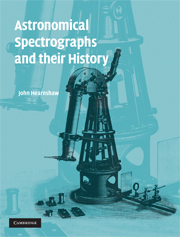Book contents
- Frontmatter
- Contents
- Preface
- Acknowledgements
- 1 The historical development of astronomical spectroscopes and spectrographs
- 2 The theory of spectroscopes and spectrographs
- 3 High resolution spectrographs
- 4 Solar spectrographs and the history of solar spectroscopy
- 5 Objective prism spectrographs
- 6 Ultraviolet and nebular spectroscopy
- 7 Multi-object spectrographs
- 8 Ten pioneering spectrographs of the late twentieth century
- Figure sources and acknowledgements
- Name index
- Subject index
1 - The historical development of astronomical spectroscopes and spectrographs
Published online by Cambridge University Press: 07 September 2010
- Frontmatter
- Contents
- Preface
- Acknowledgements
- 1 The historical development of astronomical spectroscopes and spectrographs
- 2 The theory of spectroscopes and spectrographs
- 3 High resolution spectrographs
- 4 Solar spectrographs and the history of solar spectroscopy
- 5 Objective prism spectrographs
- 6 Ultraviolet and nebular spectroscopy
- 7 Multi-object spectrographs
- 8 Ten pioneering spectrographs of the late twentieth century
- Figure sources and acknowledgements
- Name index
- Subject index
Summary
COLOUR, REFRANGIBILITY AND WAVELENGTH
The concepts of colour, refrangibility and wavelength have been crucial for the development of spectroscopes and spectroscopy. Indeed the first prism spectroscopes were built partly for measuring the refractive indices or refrangibility of different glasses, while diffraction gratings were used for early measurements of wavelength.
The refraction of light
The Dutch astronomer Willebrord Snell (1591–1626) is usually credited with the discovery of the law of refraction, in the early seventeenth century in Leiden. René Descartes (1596–1650) later included the law in his treatise Dioptrics of 1637 (without however acknowledging Snell), and he used it to account for the formation of a rainbow, but not explicitly for the colours that the rainbow produces.
Isaac Newton's (1642–1726) first paper, published by the Royal Society in 1672, but based on his optical experiments undertaken six years earlier, came to important conclusions on the relationship between refrangibility and colour. Newton studied the refraction of the Sun's rays in a glass prism, and projected the resulting spectrum onto a wall of his room. He concluded: ‘… light consists of rays differently refrangible, which, without any respect to a difference in their incidence, were, according to their degrees of refrangibility, transmitted towards divers parts of the wall.’ He found that the Sun's light was composed of rays of different primary colours, each with its different refrangibility, which gave rise to the dispersive power of the prism.
- Type
- Chapter
- Information
- Astronomical Spectrographs and their History , pp. 1 - 45Publisher: Cambridge University PressPrint publication year: 2009



